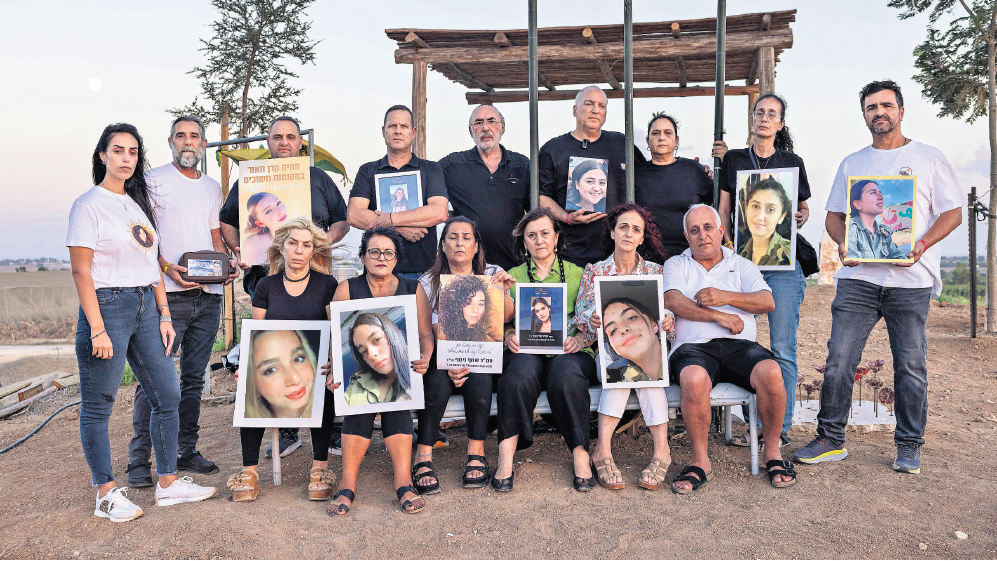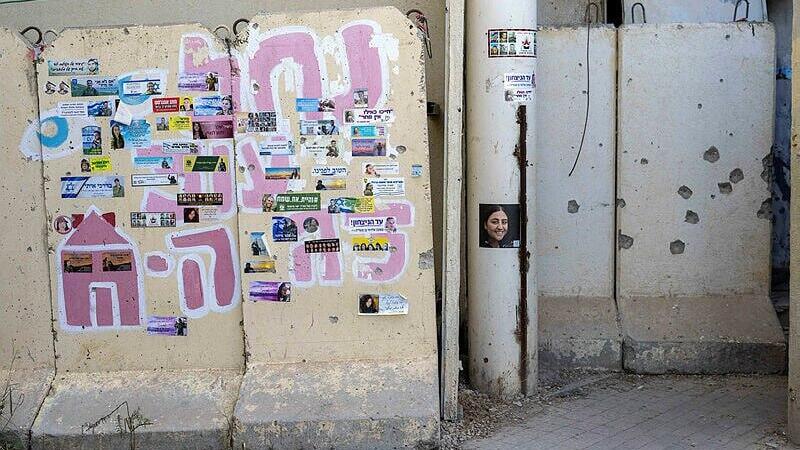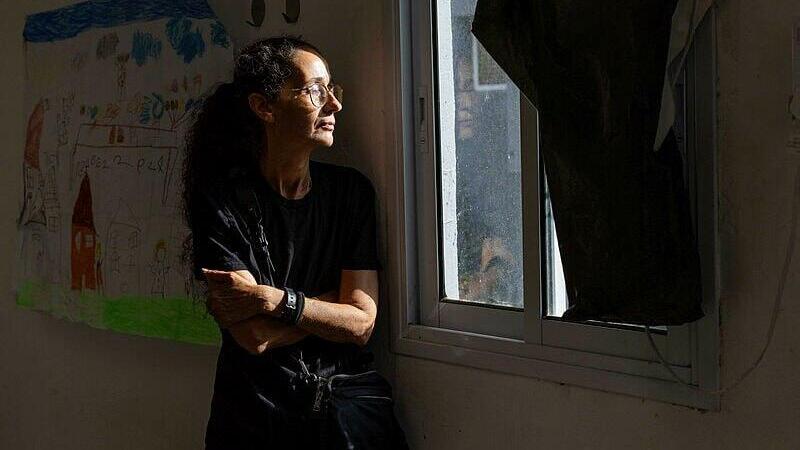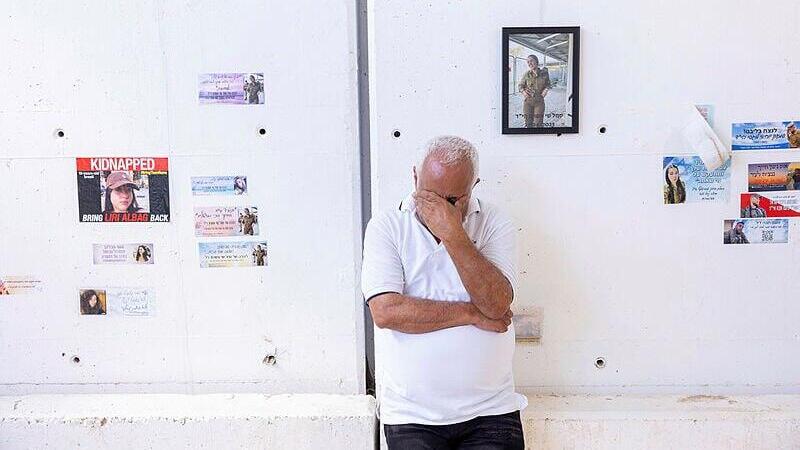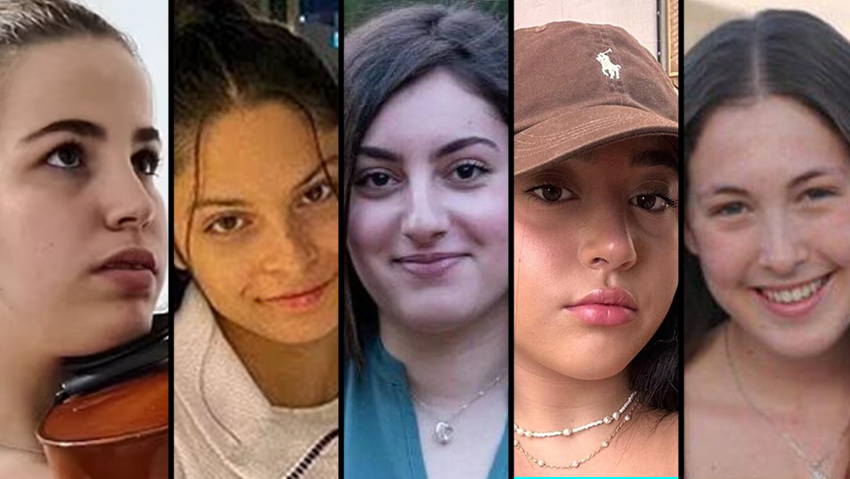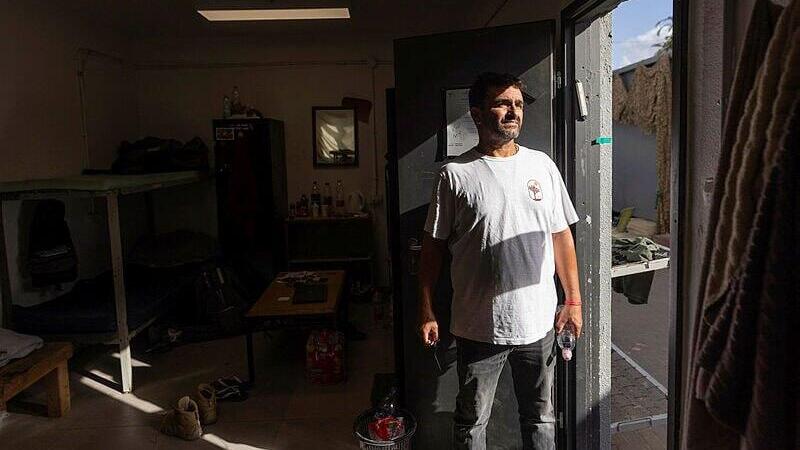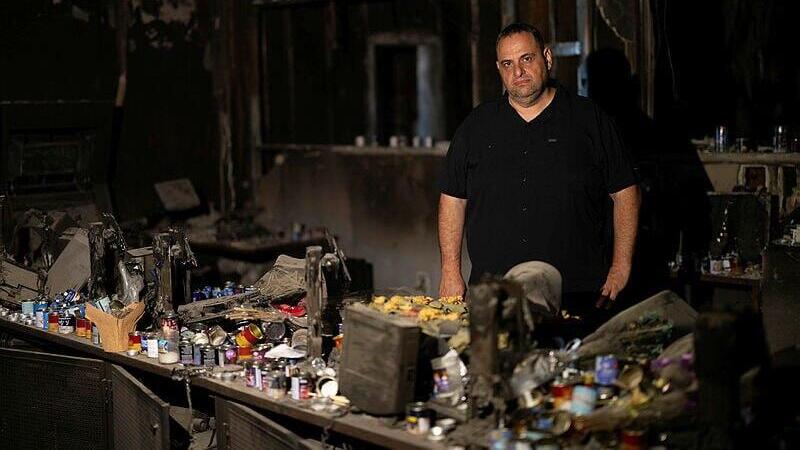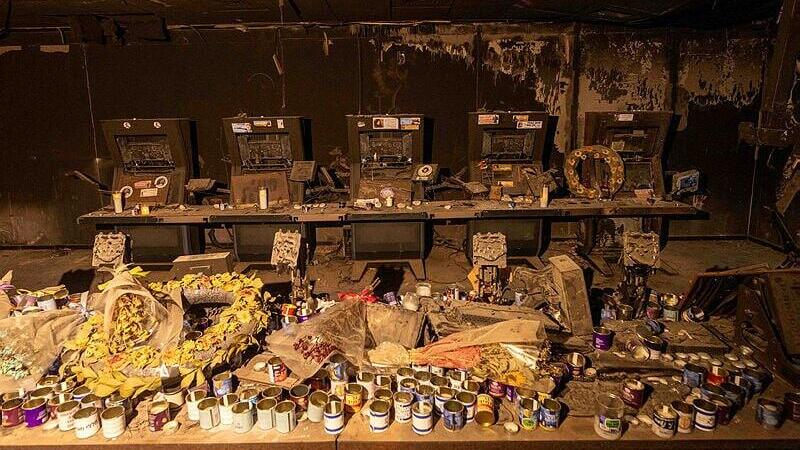Getting your Trinity Audio player ready...
An abandoned empty room stands at the entrance to the lookout soldiers’ barracks at the Nahal Oz base. Until almost a year ago it was known as the “old timers’ room,” where the longer serving lookout soldiers whose IDF release date was imminent lived.
The last women to live there before the Hamas attack were the late Staff Sgt. Shahaf Nissani and the late Staff Sgt. Noa Price. The space between its walls serves as a reminder that, on the morning of October 7, it was from there that they left for hell.
“Shahaf’s discharge date was due a few days following that Shabbat, after which Noa would have been the most veteran serving soldier, i.e., the next in line for discharge,” says her mother, Sigal Price. “She’d already started making preparations and had bought the girls goodbye presents.”
“Nahal Oz is home” reads the bold inscription at the entrance. “In the beginning, we’d come here to feel closer to her” Price continues. “We were mainly focused on the shelter where her life ended. It was a desperate attempt to feel closer to her and those awful moments of horrific agony she endured. But as time went by, I wanted to feel closer to the living side of her and the girls.
"I know how important this place was for her, how proud she was of her role but, most importantly, I know how special her friendships with the other girls were. It was her and their second home. This place must continue to exist not because they died here, but rather because these special, talented young women lived here.”
"Her fear was for the soldiers"
Fifty-two male and female soldiers, including 15 lookout soldiers, died at Nahal Oz on the morning of October 7 in one of the first and harshest battles fought that day. Seven lookout soldiers were kidnapped from the shelter after hours of being forced to watch their dead friends lie beside them.
Footage of the lookouts' abduction from Nahal Oz base — viewer discretion advised
The late Cpl. Noa Marciano was murdered in Hamas captivity and Ori Megidish was rescued from Gaza by Israeli forces at the end of October. Five lookout soldiers, Liri Albag, Karina Ariev, Agam Berger, Daniella Gilboa, and Naama Levy have been in captivity for nearly a year.
“What are we doing here?” asks Mira, the late Sgt. Aviv Hajaj’s mother, at the entrance to the mobile shelter. “Almost a year has gone by, and we can’t take in what happened here. It’s just incomprehensible that this place, the safest for my daughter, became such a horrific place. Aviv served close to 10 months at the outpost and I was never afraid when she was here, and neither was she."
"Her fear was for the soldiers. That feeling that if anything were to happen to a single soldier, it would be on their conscience for the rest of their days. That’s what she said and that’s what the girls felt. That was their worst nightmare – that something would happen on their watch.”
"This is where the first grenade was thrown from. A female soldier was standing here and she shot the terrorist who was trying to enter. They then threw another grenade, went in, and shot the girls.”
At 6:29 a.m., they ran in their pajamas from the barracks to the shelter – a few breachable concrete walls designed to protect them from rockets and mortars. With no guns, the female soldiers had no way of defending themselves. Through the gaps in the ceiling, they could see terrorists paragliding and landing in Israeli territory. For over an hour, they heard the fighting around them and the terrorists drawing closer, and then drawing further away. Some managed to send their families farewell messages.
Seven were killed in this shelter safe room: Sgt. Shai Ashram, Sgt. Aviv Hajaj, Cpl. Hadar Miriam Cohan, Cpl. Noa Abramovitch, Cpl. Shirat-Yam Amar, Staff Sgt. Shahaf Nissani and Staff Sgt Noa Price. Also killed were Capt. Eden Nimri and Staff Sgt Sivan Asraf.
No IDF investigation of the outpost battle has yet been published, but the parents have done it themselves. They spent months cross-referencing every morsel of information gathered from soldiers who survived, with video clips uploaded to social media and messages the girls were able to send. On their own, they put together the puzzle of Nahal Oz on October 7.
'They believed they'd be rescued'
“According to the video clip we got from 6:45 a.m., Noa was standing with a group of girls,” says Sigal Price pointing at a shelter wall. “Here were Daniella, Aviv, Shahaf, and Shai sitting all together. They passed Shahaf’s phone from one to the next, and each contacted her parents. They started getting messages, apparently from the war room, that there had been an infiltration.
"Noa wrote that there was a lot of shooting and everyone was frightened. At around 7:30 a.m., she wrote to us that there were terrorists inside the outpost and that it was very scary. She said there were two female soldiers with guns. She parted from us saying she didn’t know what would happen. I didn’t manage to contact her after that. She wasn’t answering.”
Price points at one of the shelter entrances and says: “This is where the first grenade was thrown from. A female soldier was standing here and she shot the terrorist who was trying to enter. They then threw another grenade, went in and shot the girls.”
Mira Hajaj, Aviv’s mother, says: “We got the last message from her at 7:38 a.m. She wrote: “Mommy, it’ll be ok, please God. Recite Psalms.”
Yigal Cohen, Hadar Miriam’s father points to another spot in the shelter. “She sat here with Ori Megidish and they screamed together. When we went to visit Ori, she told us that Hadar’s last words, a minute before the hell started, were, “May God protect our soldiers.” Until then, they could hear gunfire, screaming and shouting ‘Allahu Akbar.' But they were still optimistic about being rescued.
"They didn’t believe the terrorists would get in here. She was concerned for the male soldiers. These were her last words. Then the terrorists got in, threw in hand grenades that exploded right there. That’s what killed her. They then confirmed their kills.”
"I keep thinking about her last thoughts"
A video of the kidnapping from Hamas terrorist’s bodycams filmed in the shelter was released last May. It’s hard to watch. The girls are wounded, cuffed, and terrified. “The girls were kidnapped from this wall,” says Cohen. "They sat here for hours watching their friends drenched in blood. In the video, as they are led outside, you suddenly hear gunfire break the silence. That’s their confirmed kills. It’s the worst sound we could possibly hear.”
Haggai, father of Yael Leibushor, who was killed in the war room says: “The kidnapped girls were their friends and I’m sure that, if they were here, the most important thing for them now would be to do everything to get them back. So, we’re doing that big time. We want them here as quickly as possible.”
Dror Ashram, Shai’s father says: “If I’d have known what was going on here, I’d have been here in five minutes. I keep thinking about her last thoughts. I want to know what she thought. She sent a good friend of hers two messages: ‘You should know that I love you and that you’re my best friend’ and ‘Take care of my father and mother.' That’s the end of the conversation.”
Lookout soldiers’ families appealed to the Supreme Court last month against the IDF, demanding the voice communications and log of their daughter’s final shifts. “Why am I demanding the recordings? To hear her voice,” says Ashram. “I have SMS messages on the phone, but I don’t have her voice. I didn’t record my last conversation with her. I want to hear these things. For us, it’s more than just knowing what happened that day.”
The soot and scents remain
At the shelter entrance, the words, written in pink, “Look how calmly she walks, as if Gaza isn’t next to her,” now seem like a kick in the stomach. This sentence, that appears in the videos from that morning, came about when the girls saw a woman by the kibbutz fence, a few hundred meters from the border. “It became their slogan,” Cohen explains.
"It well describes the relationship between the girls and the kibbutzim. They saw everything – what was going on here, and what was going on in Gaza. Their aim was to allow the residents to have lives as normal and peaceful as possible as danger lurked across the fence. They saw the dangers. And yet there was life going on there, and life going on here,” according to Cohen.
"They sat here for hours watching their friends drenched in blood. In the video, as they are led outside, you suddenly hear gunfire break the silence. That’s their confirmed kills. It’s the worst sound we could hear"
A few dozen meters from there is the war room building that was supposed to be the safest at the outpost – in which 15 soldiers were killed, including 15 lookout soldiers, Capt. Shir Eilat, Sgt. Leibushor, Sgt. Ronni Eshel, Sgt. Shirl Mor, Sgt. Shira Shohat, Staff Sgt. Yam Glass, Staff Sgt. Adi Landman and CPL Mia Vialovo Polo. Two operations officers, Staff Sgt. Shirel Haim Pour and Sgt. Osher Simha Barzilay were also murdered.
Adi was in the shelter at about 6:40 a.m. and went across to the war room,” says her father, Barak Landman. “She came in here in her pajamas. I wrote her that morning asking if everything was okay.” This is his first visit to the outpost since October 7. Adi was assigned to Nahal Oz the month preceding the massacre after completing commander training and Barak visited her there shortly after that.
“I haven’t been able to come back her since what happened. I didn’t have the strength,” he explains. “I’ve seen the pictures and the videos, and had a general idea of what it looks like, but seeing the state of the burnt-out war room, all this blackness, the smell, just feeling it – it’s all so distressing.”
He's right. You can’t go into the war room without feeling a sense of dread. There’s still a stench in the air, and the total darkness illustrates what the soldiers went through in their final moments. This room that, until that Shabbat, served as the State of Israel’s eyes on North Gaza, with its smashed screens that were constantly watched by lookout soldiers, has been entirely destroyed.
Smoke. Heat. Darkness.
There was a six-hour battle between the terrorists who had broken in and the IDF soldiers on site before reinforcements showed up. Four of these soldiers fought to the last bullet from inside the war room. “They tried breaking down this door to get in,” explains Eyal Eshel, the late Ronni’s father.
“The battle was conducted from here. It’s important to remember the names of the four soldiers who fought and fell here: Warrant Officer Ibrahim Kharuba, Staff Sgt. Daniel Rashed, Lt. Yochai Duchan, and Staff Sgt. Itai Ron. We can say which lookout soldier was positioned at which station. They could see everything through the cameras from the early hours of that morning. They reported and directed the forces. The war room operated here until the very last minutes.”
At some stage, the terrorists set the war room on fire and the lookout soldiers hid in Officer Shir Eilat’s office. “They were here for a few hours, until everything filled up with smoke,” says Haggai Leibushor. “At a certain stage, they decided they had to get out because of the heat and the smoke. The electricity went out and there was total darkness. They couldn’t see anything and simply felt around what was familiar to them.”
He points at a narrow corridor leading to a tiny window. “They tried getting out of here toward the bathrooms. Only seven made it. The others choked on the smoke and fell along the way,” he said.
“One of the very worst and most painful parts of this story is that here, behind, there’s a communications room that isn’t burnt-out, with all the servers and computers, but they didn’t have the key to this room," according to Eshel. "Just think what would have happened if they had been briefed as to how to get in there in case of emergency. Had that happened, I think we’d be in a very different place right now. One of the soldiers who was here told me that they could hear the girls crying and that their voices then went silent.”
Every Saturday at 6:30 a.m.
The lookout soldiers’ parents walking around the outpost now have answers to almost every question about what happened during those hours, as well as during the following 11 months. They can’t comprehend, however, how for so many hours no one came to rescue their daughters. “I think they had faith until the very last moment that, just as they perform their duties, there would be a plan of action, and that they would be rescued any minute,” says Mira Hajaj. “But no one came.”
Sharon Eshel, Ronni’s mother says: “Coming to the outpost is hell. That’s what they went through that day. That’s what they felt. We’re dealing with endless pain and sadness. Actual physical pain. It’s a longing you can’t deal with. It’s not natural for a parent to lose their child, and the cliché about time healing all wounds is wrong. As time goes by, it gets harder and hurts more. You can’t fight something like this. It will be with us for the rest of our lives. A part of hearts has been torn out.”
The parents have set up a memorial to the soldiers a few minutes’ drive from the outpost at a lookout point from which you can see the sector they watched. “Where we’re now sitting, there were terrorists. Right here,” says Shirat-Yam’s father, Moshe Amar. "They took our flowers from us." Shirat-Yam arrived at Nahal Oz two days before October 7.
"Everything we know about the warnings the girls gave, about how they were ignored, we only heard afterward from the parents of girls who’d been there longer. She hadn’t even gotten into her role. If I had known one-tenth of what I know today, she wouldn’t have been here at all. I’d have come here physically and taken her away.”
Dror Ashram says: “We, all the families together, set up the memorial. Neither the state nor the army helped us with anything. We chose this spot because of the lookout. This is the right place.”
Shahaf Nissani’s mother and sister, Ilana and Sapir, decided not to go to the outpost itself, but rather to meet the others at the memorial. They had visited the outpost on October 6, bringing the girls food for Shahaf’s discharge party that night. "I haven’t been at the outpost, and I’ll never go in there,” says Ilana.
“I want to remember the place and the girls as they were on October 6 – a sunny day with a blue sky and white clouds, and the girls laughing, happy, and as alive as can be. I don’t want to remember the place as it is today, like an extermination camp. We’re a year on and it’s still very hard for me. It’s hardest on Shabbat mornings 6:30 a.m.–8:00 a.m. It doesn’t get any easier. Every little thing reminds me of her. I miss her so much it drives me crazy.”
'Dad, get ready. There’s going to be a war’
It's been a year since the October 7 attack and no commission of inquiry has yet been set up to investigate the circumstances, events and failures that led to the disaster. In recent months, the families of the lookout murdered soldiers murdered at Nahal Oz have been fighting for a state commission of inquiry.
“The lookout soldiers knew. Their commanders knew. Everyone knew and warned,” says Noa Marciano’s father, Avi. “They saw them training, saw a sign reading ‘We’re on our way to you, Nahal Oz.' During Sukkot, over dinner, Noa said to me, ‘Dad, get ready. After the holidays, there’s going to be a war.' And that’s what happened. On the last day of the holidays, the war began.”
9 View gallery


Memorial for IDF lookouts outside the Nahal Oz base established by hostages and bereaved families
(Photo: Tal Shachar)
“With the few exceptions of those who’ve resigned, the leaders, both military and political, of October 6 are those leading us today. The more time elapses, the more details fall away, evidence disappears, people forget things. As time passes, the harder it is to investigate the truth. There’s a sense that there’s a hot potato going around here.
"Everyone’s passing the buck onto someone else and, in the end, it all dissolves and no one takes responsibility for what happened there. The fact that a state commission of inquiry hasn’t been set up yet burns every day anew. I spend a lot of time at the cemetery. And I talk to Noa each time. I first tell her that I’m sorry. I’m sorry that those who brought about your death, still haven’t started being brought to justice.”
Get the Ynetnews app on your smartphone:



